Next to the invisible signature!
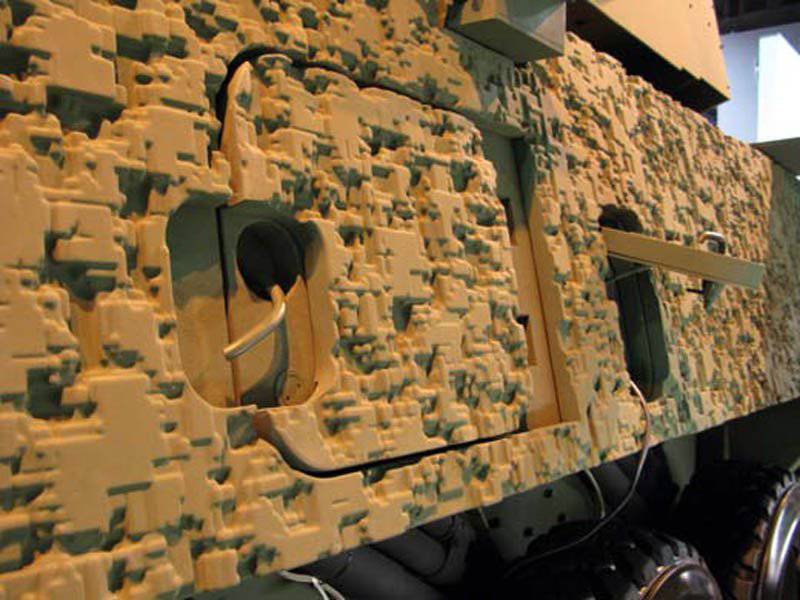
The innovative 3D invoice TactiCam camouflage from ArmorWorks has the potential to reduce vehicle signatures in the radio, infrared and visible spectrum. The outer layer of TactiCam material is randomly formed into a three-dimensional structure with various geometric shapes having different depth levels. This computer-generated messy structure reflects the energy from the machine at random, preventing the object from being detected by optoelectronic and millimeter sensors. This material can be used with materials that absorb / reduce infrared or radar radiation, and can also be filled with insulating material, which reduces its own thermal radiation and heat from excessive solar heat.
For millions of years, the animal kingdom has created innovative ways of camouflage, but people are comparative newcomers to this art. The masking of military vehicles for mixing them with the external environment, which has been used in practice for more than a century, has developed by leaps and bounds over the past decade.
RљR RјSѓS ° "P" ° RoSЂRѕRІR RЅRoRμ RІRѕRμRЅRЅS <C ... RјR ° C € RoRЅ RЅRμSЃRμS, PI SЃRμR ± Rμ RЅRμSЃRєRѕR "SЊRєRѕ SѓRЅRoRєR ° F" SЊRЅS <C ... RїRѕ SЃR "RѕR¶RЅRѕSЃS,Ro P · P ° RґR ° C ‡: S,R ° RєRoRμ RјR ° C RoRЅS € <RєR ° Rє RїSЂR ° RІRoR "of the PS, SЏRІR" SЏSЋS,SЃSЏ RєSЂSѓRїRЅS <RјRo RѕR ± SЉRμRєS,R RјRo ° C ‡ S,Rѕ SЃR ° ± RјRѕ RїRѕ SЃRμR Рµ Р · Р ° С‚СЂСѓРґРЅСЏРµС ‚РёС ... РјР ° СЃРєРёСЂРѕРІРєСѓ. РљСЂСѓРїРЅС ‹Рµ РґРІРёРіР ° тел Рё этих РјР ° С € РёРЅ Р · Р ° С З Р ° стую СЏРІР »СЏСЋС‚СЃСЏ РѕС ЗЗ РµРЅСј СЌР €С ± С ±Р ±С ± С ±Р ±С ± С ±Р ±С ± С ±Р ±С ± С ±Р ±С ± С ±Р ± "RμRіS RμS ‡ P °, P ° Roes ... ‡ RєSѓSЃS,RoS RμSЃRєRѕRμ RѕR ° ± RЅR SЂSѓR¶RμRЅRoRμ, RІS <RґR ° RμS, Roes RїRѕR ... † · Roes RoSЋ Ryo RЅR ° RїSЂR ° RІR" RμRЅRoRμ RґRІRoR¶RμRЅRoSЏ. RS Р Рё РґРІРёРіР ° тели РІС‹ СЂР ° Р ± Р ° С‚С ‹РІР ° СЋС‚ РјРЅРѕРіРѕ теплР°. RџRѕRІRμSЂS ... RЅRѕSЃS,Ro RјR ° C RoRЅS € <S,RѕR¶Rμ RІRЅRѕSЃSЏS, SЃRІRѕSЋ P "RμRїS,Sѓ, RѕSЃRѕR ± RμRЅRЅRѕ RєRѕRіRґR ° RѕRЅR RїSЂRѕRІRμR °" ° F RІRμSЃSЊ RґRμRЅSЊ RЅR ° SЃRѕR "† RЅS Rμ. P RєR ° Rє SЃR "RμRґSЃS,RІRoRμ, RoRЅS,RμRЅSЃRoRІRЅRѕRμ RoRЅS" SЂR ° ° RєSЂR SЃRЅRѕRμ Röhr · R "SѓS ‡ RμRЅRoRμ With ... € RѕSЂRѕS of the PS RІRoRґRЅRѕ RїRѕSЃSЂRμRґSЃS,RІRѕRј S,RμRїR" RѕRІRoR · RѕSЂR °. РЈРіР »РѕРІР ° ты Рµ С „РѕСЂРјС‹ РјР ° С € РёРЅС ‹РјРѕРіСѓС‚ Р ± С ‹С‚СЊ С ... РѕСЂРѕС € РёРј отрР° жР° тел едоРЕР R ° СЃС‚РѕС‚РЅС ‹С ... РІРѕР» РЅ РёР · Р »СѓС З Р ° емы С ... СЂР ° РґР ° СЂРѕРј, предстР° РІР РЅРёР · Рј посредством которого РѕРЅРё РјРѕРіСѓС ‚Р ± С‹ ть РѕР ± РЅР ° СЂСѓР¶РµРЅС ‹. Р, РЅР ° РєРѕРЅРµС †, СЃРѕ времени первого РїРѕСЏРІР »РµРЅРёСЏ tanks RЅR ° RїRѕR "Rμ P ± RѕSЏ PI RџRμSЂRІRѕR№ RјRoSЂRѕRІRѕR№ RІRѕR№RЅRμ RІRѕRμRЅRЅS <Rμ RјR ° C RoRЅS € <RѕSЃS,R SЋS,SЃSЏ ° C ... RѕSЂRѕS € RІRoRґRЅS of the PS <RЅRμRІRѕRѕSЂSѓR¶RμRЅRЅS <Rј RіR" R ° R · RsPј.
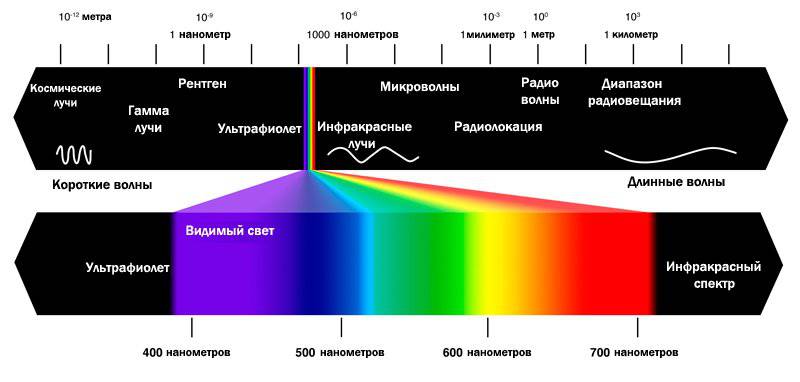
Visible spectrum
Therefore, techniques for reducing vehicle signatures should focus on four separate tasks, namely, reducing acoustic, thermal, visible, infrared and radio frequency signatures. Of course, the world's best scientific and engineering minds still have to create such a machine, in which all these signatures are reduced to zero. To do this, you must actually “hide” the machine, and thus make it invisible, but today it definitely belongs to the field of science fiction. In addition, the business of reducing signatures is based on trade-offs: for example, it may and would be easier to reduce the radio frequency signature of the machine, but only by increasing the visual signature. Consequently, the designers and machine operators must to some extent reach a compromise in the signature reduction mechanisms they have chosen to use. Around the world, active work is being done so that future generations of ground combat vehicles would be harder to see compared to their predecessors, and existing machines could accept those improvements that would further reduce their signatures.
JLTV
In several projects of promising military machines, signature reduction techniques are widely used. One example is the JLTV perspective vehicle program, which aims to create for the American army a marine corps and special operations forces to replace the existing HMMWV family. Unlike its predecessor, JLTV was created from the very beginning with an eye to participating in high intensity battles. Methods for reducing signatures are contained in the JLTV requirements, which include a smoke screen setting system to mask the machine from conventional visual detection, laser designator and weapons laser-guided.
CARC
Currently, the United States Marines and Army use the CARC (Chemical Agent Resistant Coating) system. This paint and varnish coatings of various colors and shades are designed for camouflage vehicles used by these types of troops. Along with a decrease in the visual signature of the machine due to the actual masking effect of the CARC coating, there are several other qualities. Firstly, these substances are completely non-absorbing and therefore chemical and biological substances are not kept on the surfaces of the machine and therefore they are easy to clean from foreign substances of this kind. Secondly, these coatings have some impressive properties that help reduce heat signature. One of the shades of green available from the CARC palette has a smaller IR signature than chlorophyll. After covering the car with this shade it becomes quite difficult to detect it with thermal imaging devices in a wooded area.
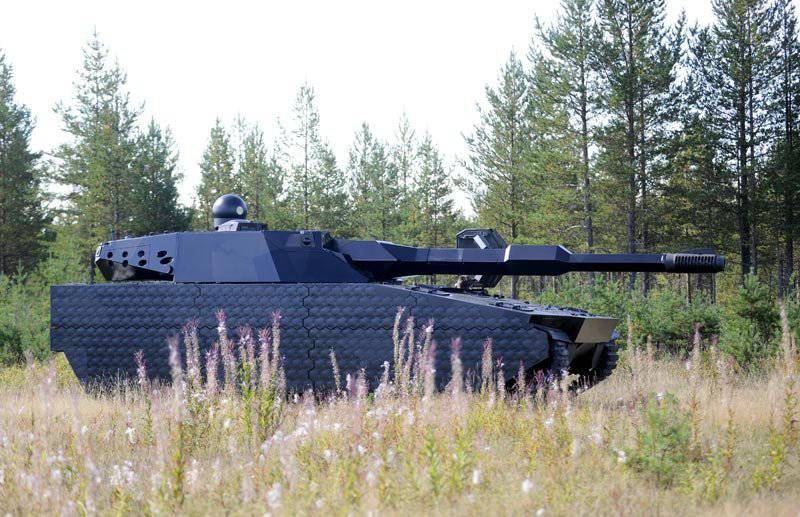
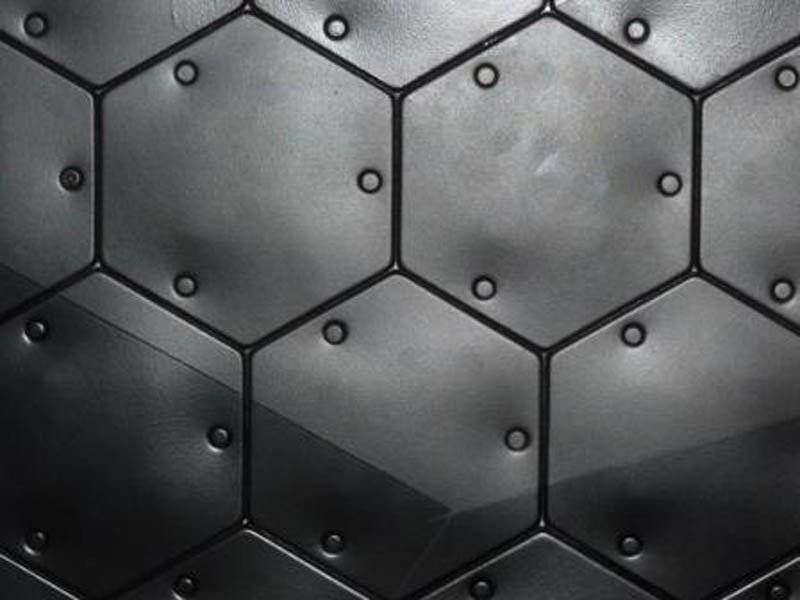
The ADAPTIV camouflage system from BAE Systems is a coating of hexagonal tiles attached to the surface of the machine, which is controlled by sophisticated software. This system actually makes the car invisible to IR sensors.
Video presentation system ADAPTIV with Russian subtitles
ADAPTIV
The technology ADAPTIV from BAE Systems uses hexagonal tiles (pixels) mounted on the surface of the machine. Cameras placed on the machine are able to scan the terrain for information on the background IR radiation of the environment surrounding the machine. Next, the voltage is applied to the tiles in order to change their temperature, which allows them to “merge” with the surrounding thermal environment. Pixels can also be heated to produce a thermal signature similar to the signature of another vehicle, such as a civilian car or truck. Another useful feature of this technology is that it can be used to broadcast a unique thermal identification tag of “your car”. BAE Systems has already tested the ADAPTIV system aboard its CV90 tracked BMP.
Intermat
Greek company Intermat has been working on reducing signatures since 1989 of the year. Then the company began its activities to create a coating that could be used on military vehicles to reduce the visual and thermal signatures. As a result, a series of reducing signatures of paints with the characteristic name CHAMELEON was obtained. These colors at Intermat say that they “minimize, and in some cases,“ nullify ”the thermal signatures of any vehicle or building and externally present it for a thermal imager or armament with IR guidance much colder than the surrounding terrain. The rocket will lose its target, and the car will merge with the background when viewed through a thermal imaging device. " Along with these coatings, the company produces other signature-reducing materials that can be used on military vehicles. These include "wheel covers and windshields, self-adhesive camouflage anti-thermal systems and anti-thermal fabrics." One example, which the company cites, is the work performed for the self-propelled installation of the MLRS HIMARS - a platform that "always moves and shoots in different conditions." The Intermat solution includes anti-thermal coatings, wheel covers and glass coatings, plus self-adhesive anti-thermal camouflage to protect moving parts of the machine. The result, the company says, is the following: “The moving units and tactical capabilities are not affected in any way. We added stealth without any negative impact on the original capabilities of the machine. "

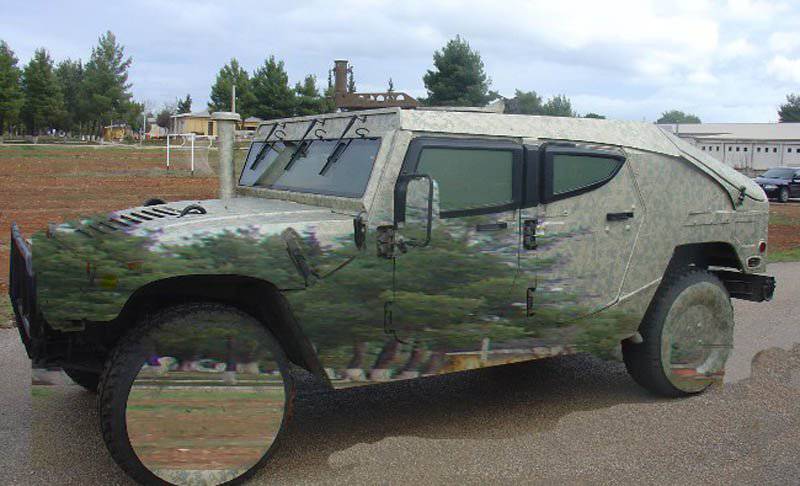
Intermat's Chameleon Series coatings can be used on machines of various sizes, helping to reduce their thermal and visual signatures. These coatings are offered either in the form of paints or in the form of adhesive materials.
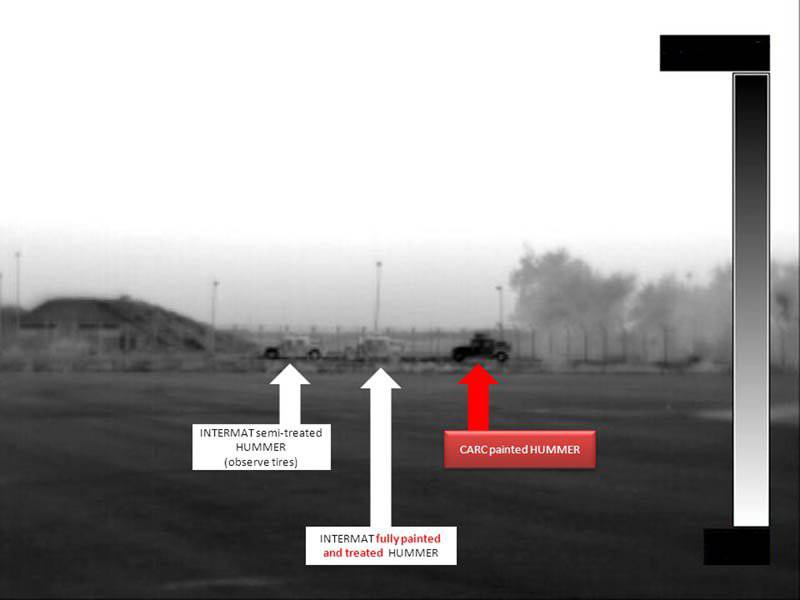
HUMVEE on the right in the picture is closed with the usual camouflage CARC, on the left, Intermat CHAMELEON has been applied to the car (except for the wheels). The car in the center of the wheel and the body are covered with Intermat coatings.
The company prefers to remain in the shadows, given that the armed forces around the world are actively acquiring its products, which reduce signatures. Although they do not hide there that it was applied on various platforms, including the Krauss-Maffei-Wegmann LEOPARD and Nexter LECLERC MBT; BAE Systems M113 and Russian BMP, as well as universal cars HUMVEE.
Swedish signature reduction system
Saab Barracuda provides solutions across the entire spectrum of systems for reducing unmasking signs. These specialized systems, created to match both the object and its environment, provide the necessary level of protection. In other words, a full range of custom signature management solutions that provide multispectral protection for any object in any situation.
Armored vehicles are used to support combat operations in a wide range of environments with constantly changing threats and their intensity. Since cars are most vulnerable while driving, mobile camouflage is a very important part of equipment. Saab Barracuda offers various mobile camouflage solutions. Not only these solutions protect against enemy sensors and the detection of the enemy, for example, HeaT Reduction System, also reduces the internal temperature of the machines, thereby increasing the efficiency of personnel and the life of electronic equipment.

Mobile Camouflage System Camouflage System (MCS) by Saab Barracuda (photo and video above) is designed to provide protection for stationary and moving vehicles. The basis of the MCS is a non-reflective surface on which a three-dimensional pattern is superimposed. This system helps to reduce not only visual and infrared signatures, it also provides a certain level of protection against radar detection and armament with radar guidance.
TactiCAM
The company ArmorWorks has developed its system of three-dimensional panels TactiCAM (see the first photo), which covers the surface of the machine. TactiCAM works through the use of randomly generated 3D forms that contribute to the disruption and deformation of the visual signature of the machine. In addition, these panels can be filled with special materials to reduce the thermal signature of the machine and at the same time reduce the amount of solar heat absorbed by the machine during the day. This is a very important parameter.
BLACK FOX
Israeli companies, such as Eltics, have occupied an impressive niche in the field of reducing military vehicle signatures. It is quite possible due to the fact that Israeli vehicles regularly participate in hostilities, specialized technologies, such as the BLACK FOX system from Eltics, appeared in this country. BLACK FOX can be installed on the machine either in the form of panels on top of existing armor, or as part of multilayer armor to reduce the thermal signature of the machine. Eltics began developing the BLACK FOX system in 2006, and since then it has demonstrated the capabilities of this system in providing protection for stationary and moving military vehicles. The product is designed to be installed on almost all surfaces of the vehicle, including the roof, which is often particularly vulnerable to detection. At the same time, Eltics noted that it is not necessary to close the entire machine with the BLACK FOX system in order to provide an impressive level of reduction in thermal signature. Even covering a part of the surface of a machine ensures that its thermal signature fails to some extent, and as a result, the efficiency of thermal imaging equipment is appropriately reduced.
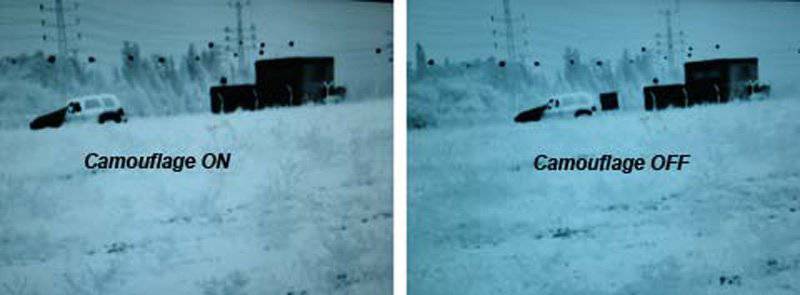
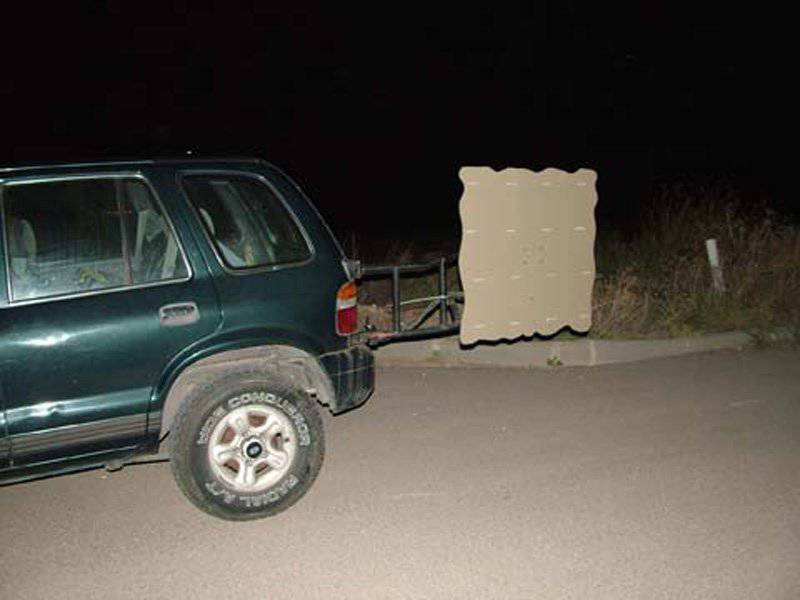
Demonstration of the system BLACK FOX on the example of one panel
Video demonstration of the BLACK FOX system
The BLACK FOX system is based on two panoramic cameras mounted on the machine and scanning the surrounding space on 360 °. This final scan enters the image processing computer, which then projects an image similar to the background on the panels attached to the machine. Each panel contains thousands of pixels that are controlled by a digital processor. They produce a thermal signature similar to the thermal signature environment. In this regard, the BLACK FOX system is akin to the ADAPTIV technology developed by BAE Systems. The IR resolution of each pixel is adjustable in the 3 - 5 and 8 - 12 micron range, and the panels can be installed in particularly hot areas of the machine, for example, on the exhaust pipe or gun barrel. Since the cameras constantly scan the horizon, they are able to change the thermal signature of the car, both in motion and in the parking lot.
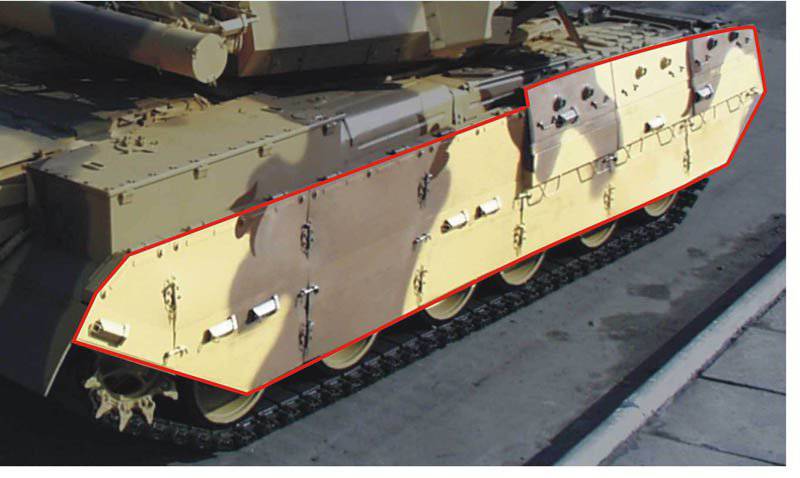
Ukrainian Machine-Building Plant. Morozova offers a number of signature products for customers of armored vehicles, such as side screens to cover and camouflage tracks and wheels
Graphite foam
In the future, new and emerging materials will offer a significant reduction in vehicle signatures. The Oak Ridge National Laboratory in the United States proposes the use of HCGF (Highly Conductive Graphite Foam) electrically conductive graphite foam development as a means of reducing vehicle thermal signatures. Graphite foam has two particularly useful properties: it is an excellent conductor of heat, but it is extremely light. Military vehicles receive two advantages here: foam contributes to cooling the main components exposed to intense heat, such as an engine, radiators and brakes, and at the same time reduces thermal signatures. The possibility of using HCGF as a heat sink is close to this, which theoretically would allow smaller radiators to be installed on heavy armored vehicles. This would contribute to reducing the overall mass of the machine and the design of housing designs that are less susceptible to radio frequency detection. In addition, the laboratory's official brochures state that HCGF reduces the electromagnetic and acoustic signature of the machine. This is achieved due to the excellent sound-absorbing characteristics and good electrical conductivity, which contributes to the absorption of radar waves. Such materials could offer another vehicle signature reduction mechanism in the future.
Never before has the problem of reducing the various signatures of vehicles — thermal, radio frequency, acoustic, and visible — been so acute. Advanced detection tools are no longer the prerogative of several armies capable of financially allowing various detection tools. Now in any large store you will find quite affordable equipment: night vision digital cameras and even thermal imaging equipment. Such civilian devices can easily be used by rebels in the field to localize and target military vehicles. Not to mention the widespread worldwide advanced sensory devices for use in high-intensity combat. Good ones news for combat vehicle operators, the methods and materials for reducing signatures are becoming more sophisticated and less expensive. The ancient Chinese military strategist Sun Tzu noted that the whole war is based on deception. Current and future vehicle signature reduction techniques take his prediction into the future.
Materials used:
Military Technology 2 / 2013
http://www.baesystems.com
http://www.saabgroup.com
Information